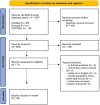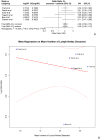Risk factors for lower limb lymphedema after gynecological cancer treatment: a systematic review
- PMID: 40463868
- PMCID: PMC12129805
- DOI: 10.3389/fonc.2025.1561836
Risk factors for lower limb lymphedema after gynecological cancer treatment: a systematic review
Abstract
Introduction: As treatments in gynecological cancer improve, the number of cancer survivors increases, with more patients facing long-term side effects of their treatment. One debilitating side effect is lower limb lymphedema (LLL). Unlike upper limb lymphedema (ULL), diagnosis of LLL remains challenging due to the absence of a clear definition, bilateral presentation complicating comparison, and confusion with post-operative weight changes. This systematic review investigated incidences and risk factors for LLL.
Methods: We systematically searched PubMed, Embase, and CENTRAL databases for articles on LLL following treatment for pelvic gynecological cancer from 1979 to November 2024. Two independent researchers extracted data, based on predefined inclusion and exclusion criteria. We assessed bias using the Risk of Bias in Non-Randomized Studies (ROBINS-I) tool and adhered to PRISMA reporting guidelines.
Results: Our review included 46 studies, with incidence rates varying widely across cancer types: 7.4-55.9% in cervical cancer, 1.2-47% in endometrial cancer, 5.6-30.4% in ovarian cancer, and 10.1-43% in vulvar cancer. Several risk factors for LLL emerged. Notably, lymphadenectomy, the number of removed lymph nodes, radiotherapy, and a body mass index (BMI) exceeding 25 kg/m² were significant risk factors. Surgical technique did not impact LLL risk.
Conclusion: LLL frequently occurs following gynecological cancer treatments, emphasizing the importance of careful monitoring and proactive management in clinical settings. Overall, the findings highlight the complexity and variability in risk factors for LLL across different gynecological cancers. The significant heterogeneity in study designs, populations, and methodologies underscores the need for standardized approaches in future research to better understand and mitigate the risk of LLL in these patients.
Systematic review registration: https://www.crd.york.ac.uk/PROSPERO, identifier CRD42020198642.
Keywords: gynecological cancer; incidence; lower extremity lymphedema; review; risk factors.
Copyright © 2025 Decorte, Cerckel, Kheir, Monten, Vandecasteele, Vanden Bossche, Pauwels and Randon.
Conflict of interest statement
The authors declare that the research was conducted in the absence of any commercial or financial relationships that could be construed as a potential conflict of interest.
Figures





References
-
- Baiocchi Neto G, Makdissi FBA, Cagnacci Neto R. Gynecological Cancer and Breast Cancer. In: Zerati AE, Nishinari K, Wolosker N, editors. Vascular Surgery in Oncology. Springer International Publishing, Cham: (2022). p. 163–200.
Publication types
LinkOut - more resources
Full Text Sources
Research Materials

